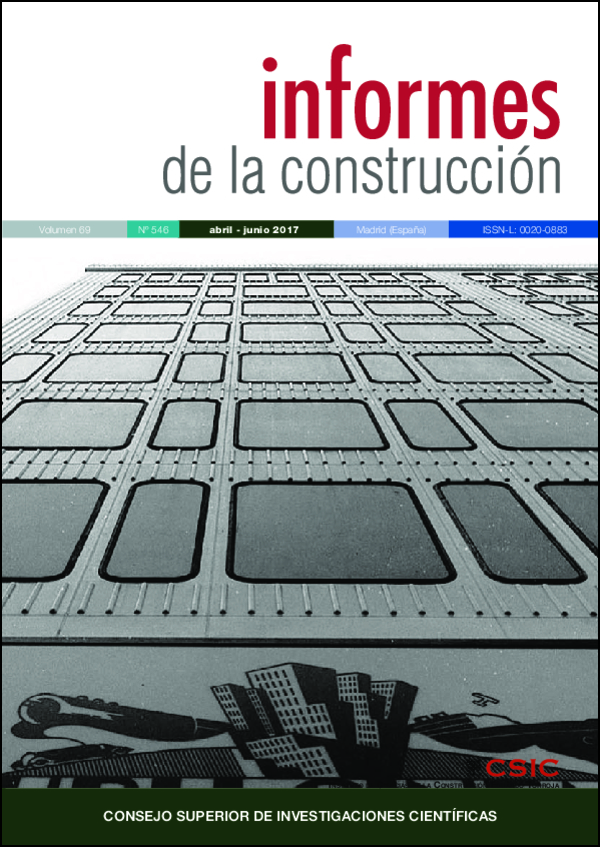Structural consumption measure concepts and their application to structures generated by bending-active elements
DOI:
https://doi.org/10.3989/ic.16.016Keywords:
structural efficiency, optimization, bending-active structure, stress volume, quantity of structure, BiclambdaAbstract
In the sphere of decision-making for resistant structures project, the mere mechanical analysis of a model does not suggest the possible material reduction resulting from changes in the structural form. In order to quantify these improvements it is essential to be able to measure the structural consumption in the early stages of design. So in this paper we present and compare two of the currently most developed theories that connect geometry with material consumption of the structure. To demonstrate the versatility of these concepts, they will be applied to a type of structure with both residual stresses and large deformations: coupled structures. This particular case of structures is generated by pre-bent elements, where the components are associated by pairs to form tied-archs groups.
Downloads
References
(1) Fernández, J. L. (1998). Estructura: tama-o, forma y proporción (Tesis doctoral). Madrid: Escuela Técnica Superior de Arquitectura, Universidad Politécnica de Madrid.
(2) Rankine, W. J. M. (1863). A Manual of Civil Engineering, London: Griffin Bohn and Co.
(3) Maxwell, J. C. (1890). Reciprocal figures, frames, and diagrams of forces. Scientific Papers, vol. II, pp. 175-177. Cambridge University Press.
(4) Michell, A. G. M. (1904). The limits of economy of materials in frame-structures. Philosophical Magazine, 8(47): 589-597. https://doi.org/10.1080/14786440409463229
(5) Otto, F. (1998). IL 24 – Lightweight principle, Stuttgart: Institute for Lightweight Structures.
(6) Miguel, J. L. de. (1974). El trabajo estructural, un nuevo escalar de las estructuras (Tesis doctoral). Madrid: Escuela Técnica Superior de Arquitectura, Universidad Politécnica de Madrid. PMCid:PMC458836
(7) González, J. A. (1990). Análisis del proceso de dise-o de estructuras porticadas (Tesis doctoral). Madrid: Escuela Técnica Superior de Arquitectura, Universidad Politécnica de Madrid.
(8) Cervera, J. (2011). Concebir y analizar estructuras. Madrid: Departamento de Estructuras de la Edificación, Escuela Técnica Superior de Arquitectura, Universidad Politécnica de Madrid.
(9) Cervera, J., Ortiz, J., Vázquez Espí, M., Aznar, A. (2013). Dimensionado en compresión en acero: el peso del pandeo. Revista Internacional de Métodos Numéricos para Cálculo y Dise-o en Ingeniería, 29(2): 79-91. https://doi.org/10.1016/j.rimni.2013.04.005
(10) Cervera, J., Vázquez, C., Vázquez M. (2014). Two near-optimal layouts for truss-like bridge structures bearing uniform weight between supports. Journal of Structural Engineering, 140(4). American Society of Civil Engineers.
(11) Lienhard, J., Alpermann, H., Gengnagel C., Knippers, J. (2013). Active bending, a review on structures where bending is used as a self-formation process. International Journal of Space Structures, 28(3&4). https://doi.org/10.1260/0266-3511.28.3-4.187
(12) Ochsenschlager, E. (1998). Life on the edge of the marshes. Expedition 40(2): 29-40. Philadelphia: University of Pennsylvania, Museum of Archaelogy and Anthropology.
(13) Lienhard, J., Schleicher, S., Knippers, J. (2011). Bending-active Structures – Research Pavilion ICD/ITKE. En Nethercot, D., Pellegrino, S. et al. (Eds.), Taller, longer, lighter. Proceedings of the International Symposium of the IABSEAISS Symposium, London, UK.
(14) Lienhard, J. (2014). Bending-Active Structures (Tesis doctoral). Stuttgart: Universität Stuttgart - Institut für Tragkonstruktionen und Konstruktives Entwerfen.
(15) Gengnagel, C., Alpermann, H., Lafuente, E. (2014). Active bending in hybrid structures. En Filz, G. H., Maleczek, R., Scheiber, C. (Eds.), FORM – RULE | RULE – FORM 2013 (pp. 12-27). Innsbruck University Press.
(16) Schleicher, S., Rastetter, A., La Magna, R., Schönbrunner, A., Haberbosch, N., Knippers, J. (2015). Form-finding and design potentials of bending-active plate structures. En Modelling Behaviour (pp. 53-63). Springer International Publishing. https://doi.org/10.1007/978-3-319-24208-8_5
(17) García, A., Monjo, J., Sakata, H., Sastre, R., Yamazaki, Y. (2016). Actively-bent plywood floor frame with in-plane curvature. En Kawaguchi, K., Ohsaki, M., Takeuchi, T. (Eds.). Spatial Structures in the 21st Century. Proceedings of the International Symposium of the IASS 2016, Tokyo, Japan, 2016.
(18) Samyn, P., Latteur, P. (2000). Volume and displacement indicators of isostatic structures the case of the horizontal isostatic span, vertically loaded. En Bridge between civil engineering and architecture. Proceedings of the 4th International Colloquium on Structural Morphology. Delft: Delft University of Technology.
Published
How to Cite
Issue
Section
License
Copyright (c) 2017 Consejo Superior de Investigaciones Científicas (CSIC)

This work is licensed under a Creative Commons Attribution 4.0 International License.
© CSIC. Manuscripts published in both the print and online versions of this journal are the property of the Consejo Superior de Investigaciones Científicas, and quoting this source is a requirement for any partial or full reproduction.
All contents of this electronic edition, except where otherwise noted, are distributed under a Creative Commons Attribution 4.0 International (CC BY 4.0) licence. You may read the basic information and the legal text of the licence. The indication of the CC BY 4.0 licence must be expressly stated in this way when necessary.
Self-archiving in repositories, personal webpages or similar, of any version other than the final version of the work produced by the publisher, is not allowed.















